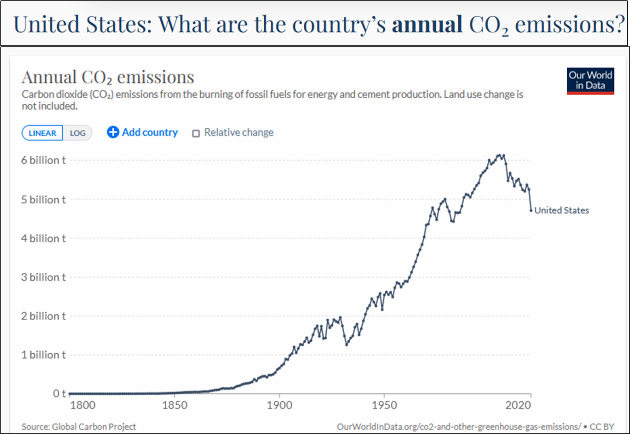“Having the right policies, infrastructure and technology in place to enable changes to our lifestyles and behaviour can result in a 40-70% reduction in greenhouse gas emissions by 2050. This offers significant untapped potential,” said IPCC Working Group III Co-Chair Priyadarshi Shukla. - The evidence is clear: the time for action is now. We can halve emissions by 2030. Press Release, Intergovernmental Panel on Climate Change. April 4, 2022
If we’re going to reduce greenhouse gas emissions 40-70% in less than 30 years, India, China, and the United States had better be on board. So how are these countries doing, emissions-wise? Let’s focus on CO2 emissions and start with India:
Not good. How about China?
Even worse. And the US?
At least the US is moving in the right direction. But look more closely and the picture’s not quite as rosy as it seems:
The US drop in CO2 emissions is almost entirely due to trends in electric power, mostly improvements in energy efficiency and the growth of renewable energy. Emissions in the transportation, industrial, residential and commercial sectors are either flat or going up - and the price of oil appears to make little difference in projections for the next 30 years. Makes me doubt the efficacy of a carbon tax in changing people’s behavior, unless of course it’s a huge carbon tax. But a huge carbon tax is likely to backfire.
This is doubly depressing, because India, China, and the US combined are responsible for half of the world’s CO2 emissions. If these three countries don’t get their act together, this poor planet doesn’t have a chance of limiting global warming to 1.5°C this century. What to do?
Keep plugging away at emissions reduction but focus more on adaptation and protecting endangered species.
Reference:
Hannah Ritchie, Max Roser and Pablo Rosado (2020) - "CO₂ and Greenhouse Gas Emissions". Published online at OurWorldInData.org. Retrieved from: 'https://ourworldindata.org/co2-and-other-greenhouse-gas-emissions' [Online Resource] https://ourworldindata.org/co2/country/india



